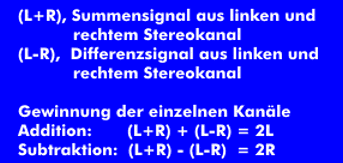UKW broadcasting
Before 1945, the frequency range between 42 MHz and 50 MHz was used for FM broadcasting. Only afterwards, after the higher frequency ranges were better mastered, was the frequency range raised to the higher and still valid frequency range between 88 MHz and 108 MHz at the suggestion of the Federal Communications Commission( FCC).
In terms of transmission technology, FM broadcasting works with frequency modulation and a frequency deviation of about 150 kHz. The audio signal is transmitted with a bandwidth between 30 Hz and 15 kHz. The modulation code for FM broadcasting is F8E
In the early years, the audio signal was transmitted only monophonically, and later stereophony was added. For compatibility reasons, the stereo signal had to be accommodated within the available transmission bandwidth and it had to be ensured that a mono radio reproduced both audio channels together, whereas a stereo radio could reproduce both stereo channels separately.
The separation of mono and stereo
For the reasons mentioned above, the stereo signal is divided into two signals: the sum signal from the left and right stereo channels (L+R) and the difference signal (L-R). The (L+R)signal is transmitted in frequency modulation and can thus be received by mono and stereo equipment, the (L-R) signal is transmitted in amplitude modulation. To prevent interference and noise from the carrier signal, a 19 kHz pilot tone is transmitted, which is thus above the audio bandwidth. This 19 kHz pilot tone is frequency-doubled and is added as a carrier frequency to the amplitude-modulated (L-R) signal transmitted with carrier suppression. As a result, the frequency ranges for (L+R) between 30 Hz and 15 kHz are formed and the two sidebands of the (L-R) signals between 23 kHz and 38 kHz and between 38 kHz and 53 kHz are formed. Later, at three times the frequency of the pilot tone, at 57 kHz, the ARI information or radio text was added.
In terms of reception, the two stereo channels for left and right are obtained from the (L+R) sum signal and the (L-R) difference signal by adding and subtracting the signals.

-Signal_en.png)
